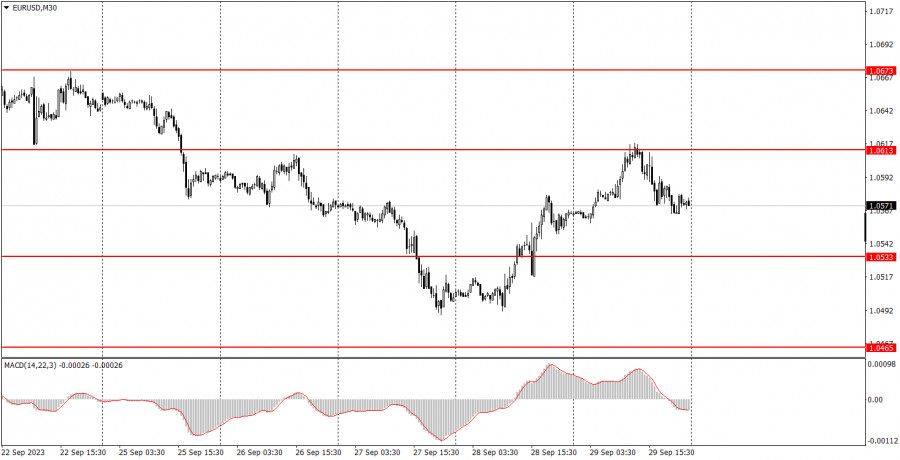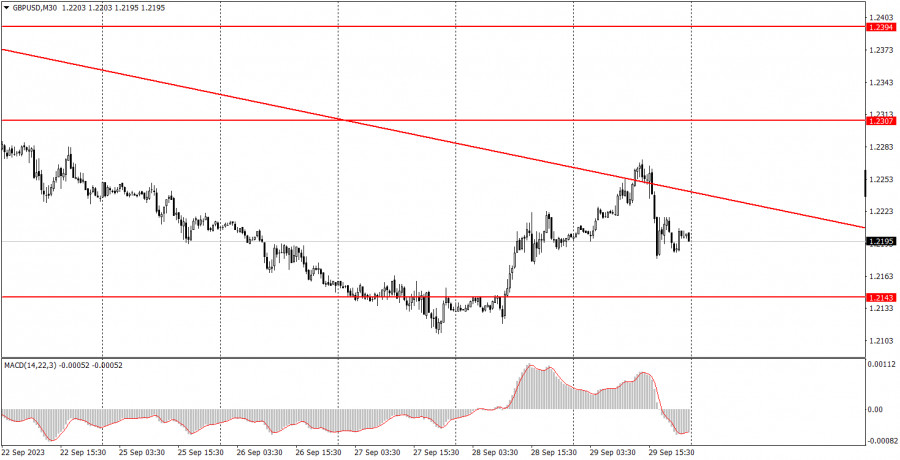

Hardly any macroeconomic events on Monday, but traders can still look forward to something interesting. Firstly, the final Manufacturing Purchasing Managers' Index (PMI) for September for Germany, the EU, and the UK. Their values are unlikely to differ significantly from the initial estimates, so we do not expect a strong market reaction.
The US ISM Manufacturing PMI will be in the spotlight, as it holds much more importance than ordinary PMIs. Forecasts for this report are more than neutral, so the hope lies in a significant deviation of the actual value from the forecast. Otherwise, we may not see any market reaction here either.
In addition, the unemployment rate in the European Union will be published, which has even less chance of influencing market sentiment than the PMIs. In general, you should only pay attention to the US ISM index.
Analysis of fundamental events:
From Monday's fundamental events, we can highlight the speeches of European Central Bank official Luis de Guindos, Federal Reserve Chair Jerome Powell, and other Fed officials Patrick Harker, and Loretta Mester. Take note that not every speech will provide important information. We would even say that only one out of every ten speeches can truly be considered interesting and significant for the market. However, it is impossible to predict which one will be important. Therefore, despite the high-profile events, the central bank officials may not mention anything interesting.
General conclusion:On Monday, there are hardly any important events, which is somewhat unusual for the first trading day of the week. The main agenda of the day will be the US ISM report, and in addition to that, there will be a series of secondary events and reports. We believe that you should not expect strong movements on Monday, and both currency pairs will likely continue to lean towards a corrective move.
Basic rules of a trading system:1) Signal strength is determined by the time taken for its formation (either a bounce or level breach). A shorter formation time indicates a stronger signal.
2) If two or more trades around a certain level are initiated based on false signals, subsequent signals from that level should be disregarded.
3) In a flat market, any currency pair can produce multiple false signals or none at all. In any case, the flat trend is not the best condition for trading.
4) Trading activities are confined between the onset of the European session and mid-way through the U.S. session, post which all open trades should be manually closed.
5) On the 30-minute timeframe, trades based on MACD signals are only advisable amidst substantial volatility and an established trend, confirmed either by a trend line or trend channel.
6) If two levels lie closely together (ranging from 5 to 15 pips apart), they should be considered as a support or resistance zone.
How to read charts:Support and Resistance price levels can serve as targets when buying or selling. You can place Take Profit levels near them.
Red lines represent channels or trend lines, depicting the current market trend and indicating the preferable trading direction.
The MACD(14,22,3) indicator, encompassing both the histogram and signal line, acts as an auxiliary tool and can also be used as a signal source.
Significant speeches and reports (always noted in the news calendar) can profoundly influence the price dynamics. Hence, trading during their release calls for heightened caution. It may be reasonable to exit the market to prevent abrupt price reversals against the prevailing trend.
Beginning traders should always remember that not every trade will yield profit. Establishing a clear strategy coupled with sound money management is the cornerstone of sustained trading success.